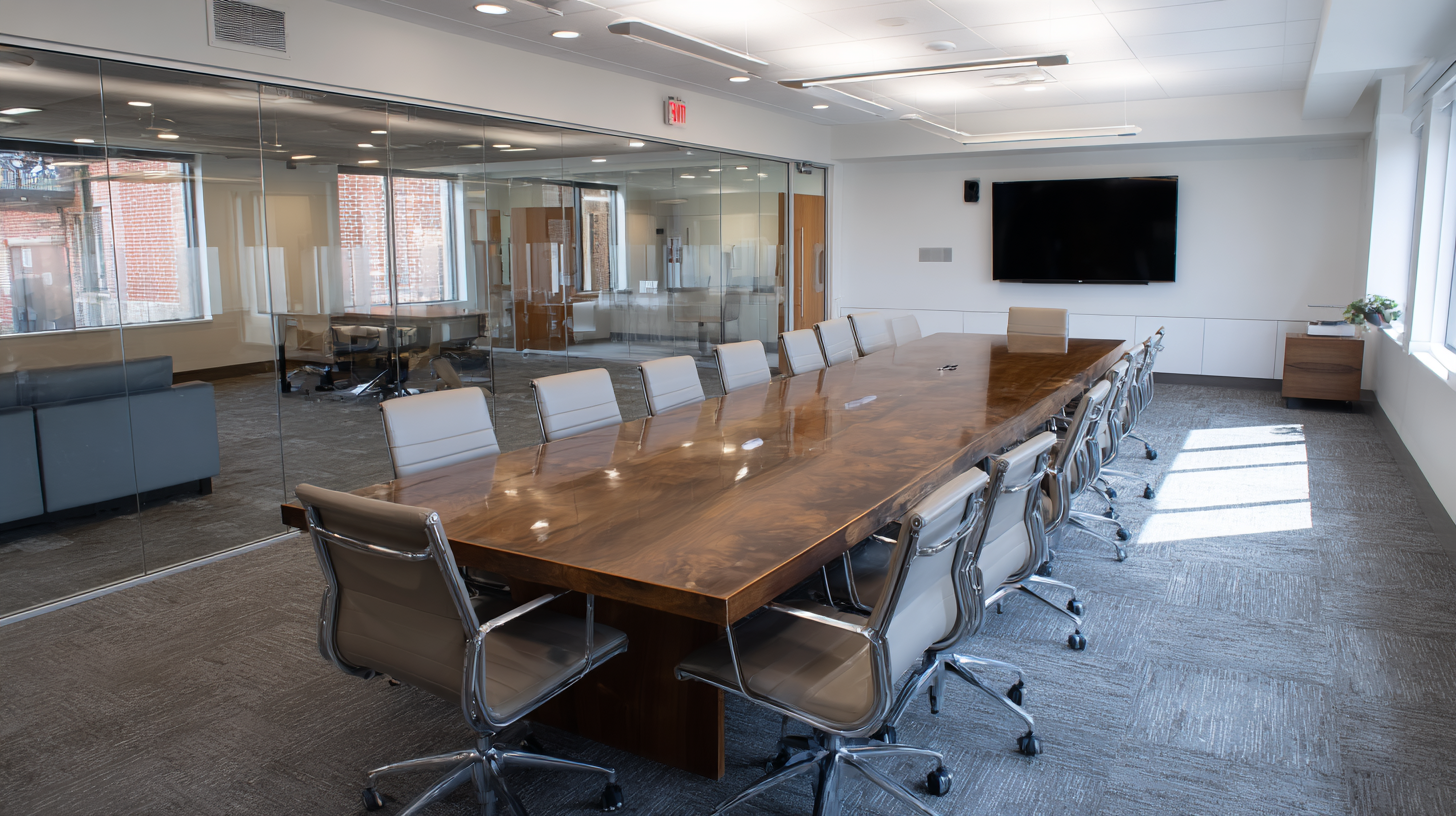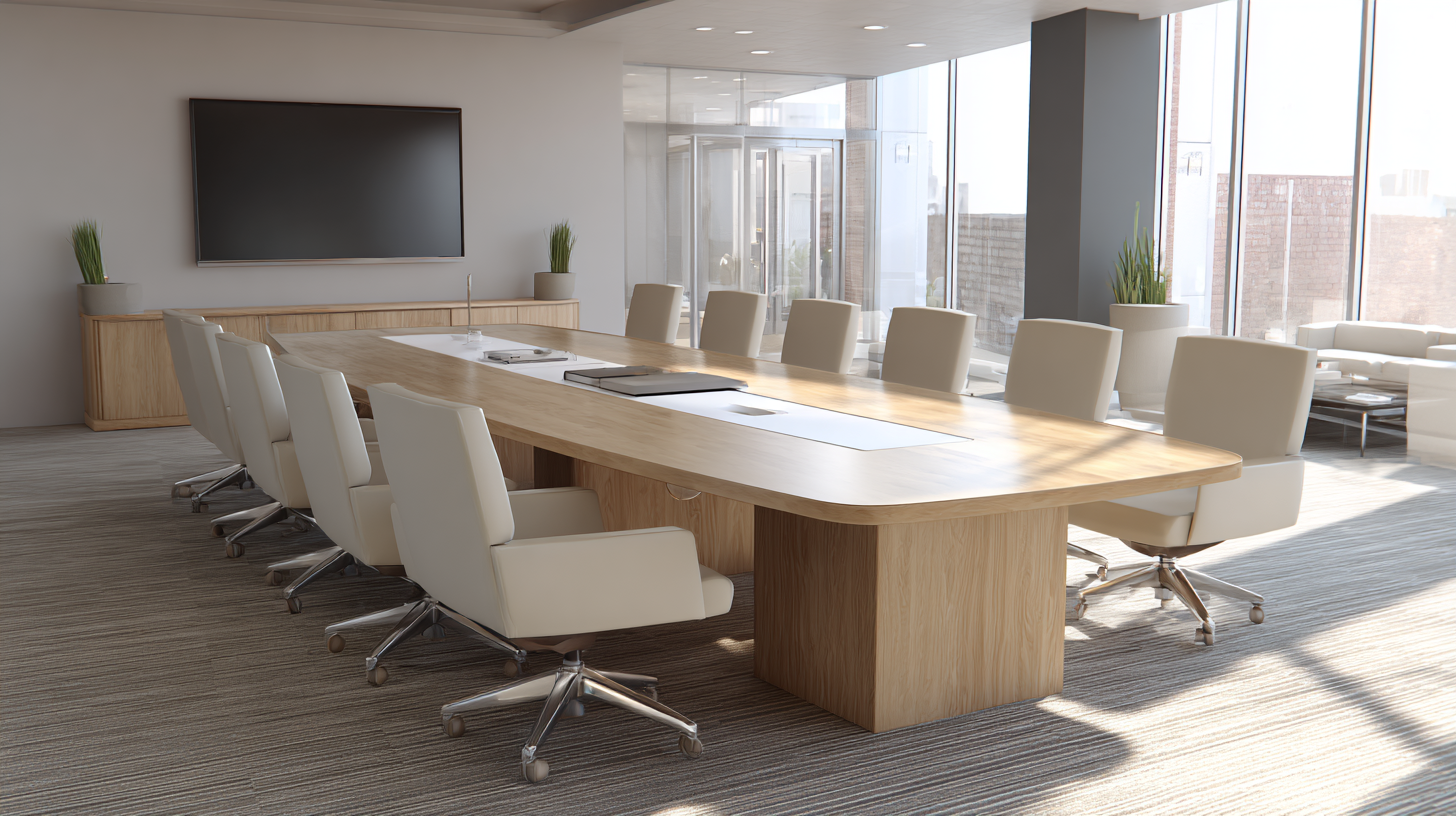Innovative Ways to Utilize the Best Conference Room Table in Collaborative Workspaces
In today's fast-paced business environment, organizations are increasingly recognizing the pivotal role of collaborative workspaces in fostering innovation and productivity. A recent report by the International Facility Management Association (IFMA) indicated that 65% of employees believe that effective collaboration enhances their job satisfaction and performance. Central to these collaborative environments is the conference room table, which serves not only as a physical focal point for meetings but also as a catalyst for dynamic interaction and brainstorming.

When designed and utilized effectively, a conference room table can enhance communication, encourage creativity, and facilitate decision-making processes. As companies strive to create environments that promote teamwork and collaboration, exploring innovative ways to leverage the conference room table becomes essential in maximizing both space and employee engagement.
Innovative Design Features of Conference Room Tables for Enhanced Collaboration
In the evolving landscape of collaborative workspaces, innovative design features in conference room tables play a crucial role in enhancing teamwork and productivity. According to recent industry reports, the hybrid work model is reshaping meeting dynamics, with organizations increasingly prioritizing adaptable furniture solutions that cater to both in-person and remote participants. For example, the integration of technology, such as AI-enabled interfaces and touch capabilities, into conference tables fosters seamless communication, enabling teams to engage efficiently regardless of their physical location.
Moreover, the emergence of multifunctional collaboration devices underscores the need for workspaces to support diverse meeting formats. As organizations invest in these advanced solutions, they are witnessing significant improvements in employee engagement and creativity during brainstorming sessions. One study highlights that companies implementing state-of-the-art conference tables report a 30% increase in collaboration effectiveness. With the right design features, including modular configurations and built-in audiovisual systems, conference tables are not just furniture; they are central hubs for innovation and collaboration in the modern workplace.
Impact of Conference Room Layouts on Team Productivity and Engagement
The layout of conference rooms plays a crucial role in enhancing team productivity and engagement. A well-designed space can significantly impact how team members interact, share ideas, and feel about their work environment. Collaborative seating arrangements, such as circular or U-shaped setups, encourage open communication and equal participation, fostering an inclusive atmosphere that boosts creativity and problem-solving. This transformation in physical space can lead to notable improvements in team dynamics and overall output.
To further enhance engagement during meetings, it's important to incorporate technology that meets the needs of modern teams. Utilizing next-gen tools can streamline workflows and maintain attention levels. For example, incorporating digital whiteboards or interactive displays allows for real-time collaboration, enabling all participants, whether in-person or remote, to contribute effectively.
**Tip 1:** Regularly reassess the layout and configuration of your conference room to ensure it aligns with your team’s evolving needs, such as adapting for hybrid working models.
**Tip 2:** Integrate employee feedback regarding space functionality and comfort to foster a sense of ownership and investment in the workspace, directly influencing morale and engagement.
Innovative Ways to Utilize the Best Conference Room Table in Collaborative Workspaces - Impact of Conference Room Layouts on Team Productivity and Engagement
| Conference Room Layout | Description | Impact on Productivity (%) | Engagement Level (1-10) | Best Use Case |
|---|---|---|---|---|
| Round Table | Encourages open discussion and collaboration | 85 | 9 | Brainstorming Sessions |
| U-Shape | Great for presentations and discussions with a focus on the speaker | 75 | 7 | Team Meetings |
| Classroom Style | Ideal for lectures and presentations to large groups | 60 | 5 | Training Sessions |
| Boardroom Style | Ideal for decision-making and discussions among executives | 80 | 8 | Strategic Planning Meetings |
| Collaborative Layout | Flexible space with movable furniture promoting interaction | 90 | 10 | Project Development |
Leveraging Technology Integration in Conference Room Tables for Remote Collaboration
In today’s fast-paced work environment, leveraging technology integration in conference room tables is critical for enhancing remote collaboration. Modern conference room tables are no longer just furniture; they are equipped with advanced technology that fosters seamless communication among team members, regardless of their physical location. With features like built-in microphones, speakers, and smart displays, these tables create an immersive experience that mimics in-person meetings, ensuring everyone feels included and engaged.
Moreover, integrating wireless conferencing tools into these tables simplifies the setup process, allowing teams to connect their devices with ease. This eliminates the need for cumbersome cables and setups that can waste valuable meeting time. By introducing smart connectivity options, participants can share screens, access shared documents, and collaborate in real-time from any part of the world. As organizations continue to adapt to hybrid work models, investing in technologically advanced conference room tables is essential to facilitate effective teamwork, drive productivity, and cultivate a collaborative workspace that meets the demands of both in-office and remote employees.
Innovative Ways to Utilize Conference Room Tables for Remote Collaboration
Sustainable Materials and Their Role in Conference Room Table Selection
 Sustainable materials are increasingly becoming a priority in the selection of conference room tables, especially within collaborative workspaces. According to a 2022 report by the Global Sustainable Materials Market, the demand for eco-friendly furniture has risen by 35% over the past five years, demonstrating a significant shift towards sustainable practices in interior design. Materials such as reclaimed wood, recycled metals, and eco-friendly laminates not only reduce environmental impact but also promote a healthier workplace atmosphere. This aligns perfectly with the growing trend of businesses prioritizing Corporate Social Responsibility (CSR).
Sustainable materials are increasingly becoming a priority in the selection of conference room tables, especially within collaborative workspaces. According to a 2022 report by the Global Sustainable Materials Market, the demand for eco-friendly furniture has risen by 35% over the past five years, demonstrating a significant shift towards sustainable practices in interior design. Materials such as reclaimed wood, recycled metals, and eco-friendly laminates not only reduce environmental impact but also promote a healthier workplace atmosphere. This aligns perfectly with the growing trend of businesses prioritizing Corporate Social Responsibility (CSR).
Tips for selecting a sustainable conference table include evaluating the source of the materials used. Look for certifications such as Forest Stewardship Council (FSC) which ensures that the wood is harvested responsibly. Additionally, consider finishes and adhesives that are low in volatile organic compounds (VOCs) to improve air quality in the workspace.
Another crucial factor is the durability of materials. Investing in high-quality, sustainable tables means they can withstand the rigors of collaborative work, ultimately reducing waste and the need for frequent replacements. Sustainable tables can also be designed to be modular, allowing businesses to adapt their spaces as needs change, further enhancing their practicality and environmental friendliness.
Metrics for Measuring the Effectiveness of Conference Room Designs on Team Performance
When designing conference room spaces, measuring the effectiveness of the layout and furnishings on team performance is crucial. One of the key metrics to assess is team engagement during meetings. A well-organized space that encourages collaboration can significantly enhance participation levels, leading to more productive discussions. To measure this, consider using feedback surveys post-meetings to gauge participants' satisfaction and engagement levels.
Another important metric is the time taken to reach decisions. Space design can influence communication flow; thus, tracking how quickly teams arrive at decisions can provide insights into the efficacy of the conference room setup. An ideal configuration promotes open dialogue and minimizes distractions.
Tips: Opt for modular furniture that can be arranged in various formations to suit different meeting types. This flexibility can adapt to the needs of the team and improve overall collaboration. Additionally, incorporate technology seamlessly into the room design—installing screens and connectivity solutions that enhance presentations can facilitate smoother interactions and keep participants focused.

